Forex Trading Strategies for Harmonic Patterns: Techniques for Identifying and Trading Harmonic Patterns
In the dynamic world of forex trading, where market movements can be as unpredictable as they are lucrative, traders constantly seek strategies that provide an edge. Harmonic patterns, a subset of technical analysis, offer traders a structured approach to understanding price movements and making informed trading decisions. This article delves into the world of harmonic patterns, discussing their significance, techniques for identification, and strategies for effective trading.
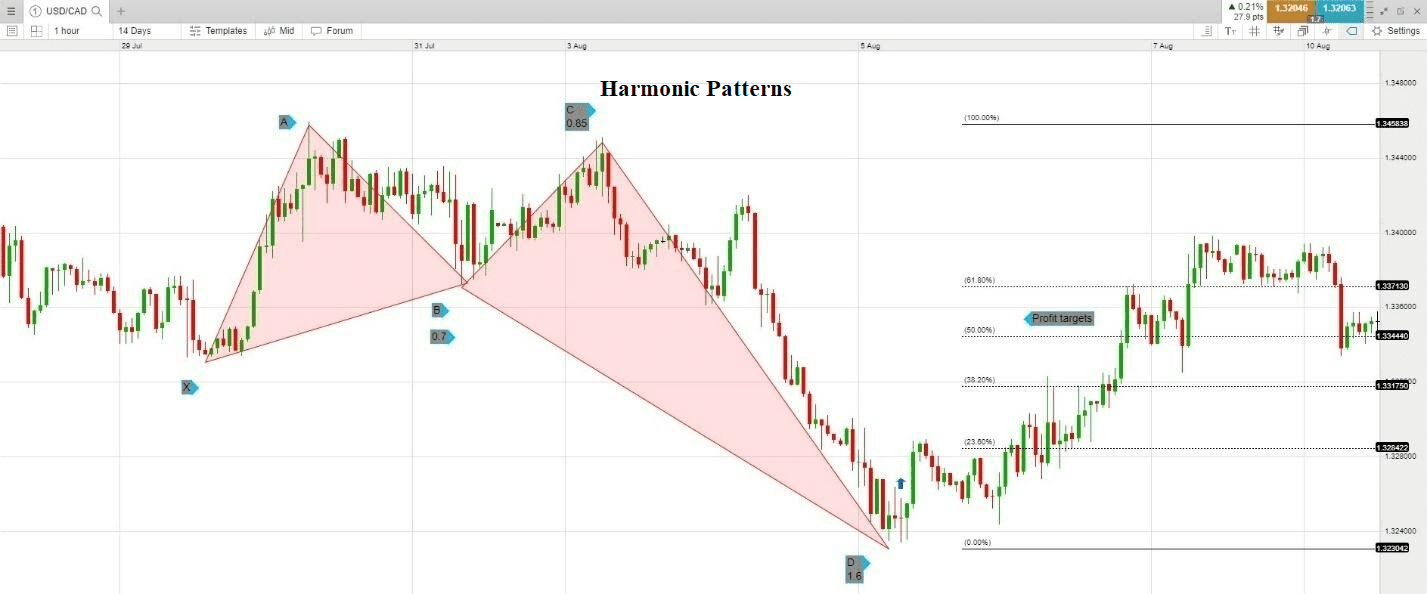
Table Content
1. Understanding Harmonic Patterns
2. Techniques for Identifying Harmonic Patterns
3. Strategies for Trading Harmonic Patterns
4. Challenges and Considerations
5. Footnote
Understanding Harmonic Patterns
Harmonic patterns are a unique form of technical analysis that seeks to identify specific price patterns that indicate potential trend reversals or continuations. These patterns are derived from the work of Harold M. Gartley, who introduced the concept of "Gartley patterns" in the early 20th century. Over time, various traders and analysts have refined and expanded upon these concepts, leading to the identification of several key harmonic patterns.
The core idea behind harmonic patterns is the concept of geometric proportions and ratios found in nature. These patterns reflect the cyclical nature of markets and how price movements tend to repeat themselves over time. Harmonic patterns are based on Fibonacci ratios and are divided into two main categories: retracement patterns and extension patterns.
1) Retracement Patterns:
a) Gartley Pattern: This pattern consists of five points labeled X, A, B, C, and D. It forms after a significant price move and indicates potential reversal points.
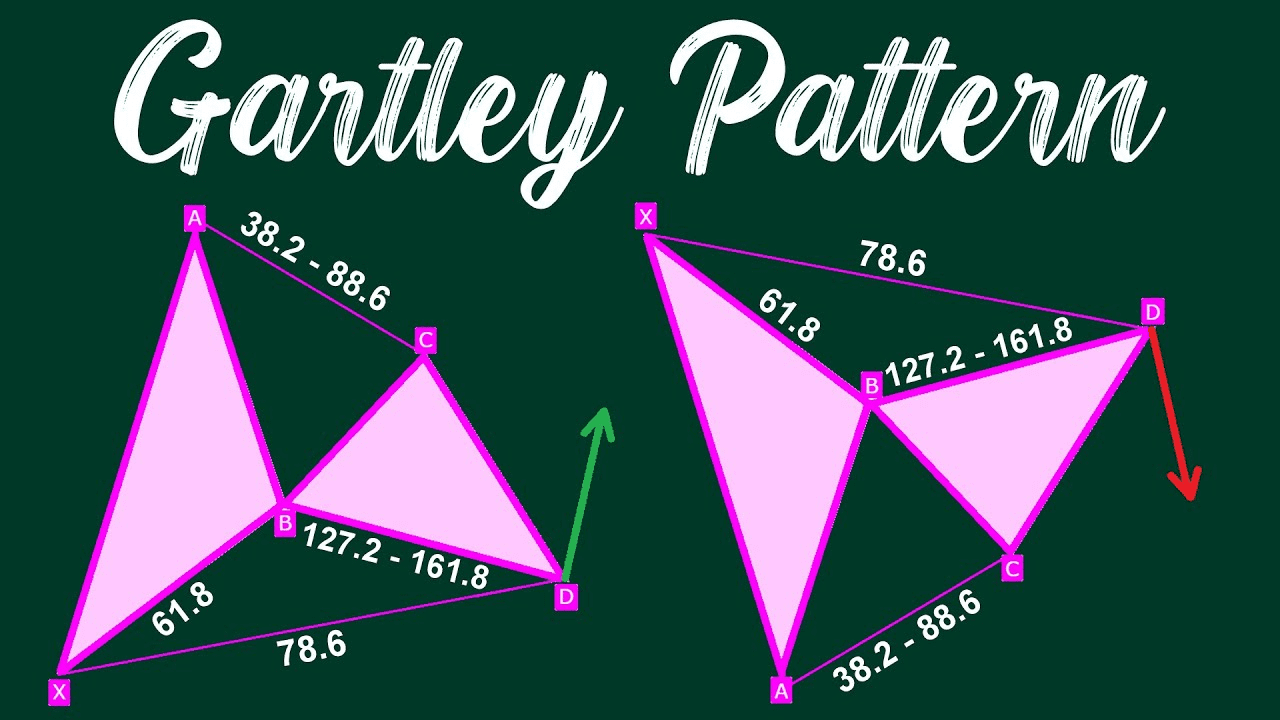
b) Butterfly Pattern: Similar to the Gartley pattern, the butterfly pattern has five points labeled X, A, B, C, and D. It's characterized by its symmetrical structure and potential reversal opportunities.
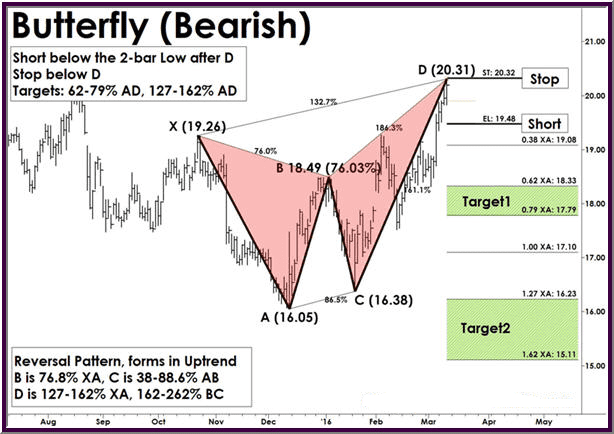
c) Bat Pattern: The bat pattern is also a five-point pattern with X, A, B, C, and D points. It's particularly useful for identifying potential trend reversals.
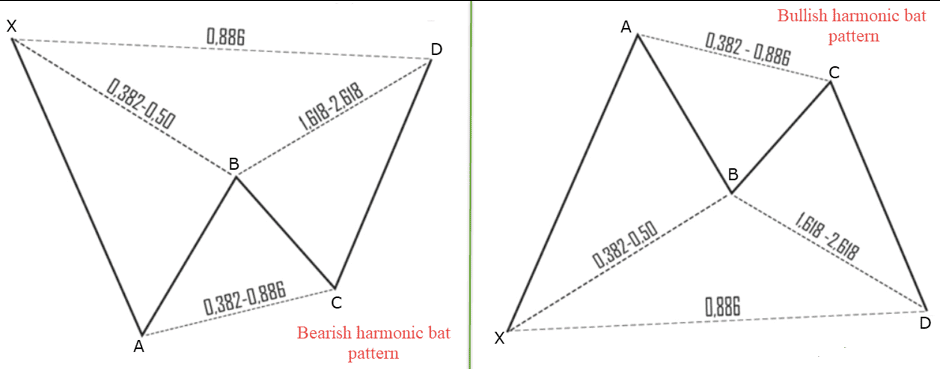
2) Extension Patterns:
a) Cypher Pattern: This pattern is composed of four points labeled X, A, B, and C. It's known for its potential to predict the continuation of a trend.
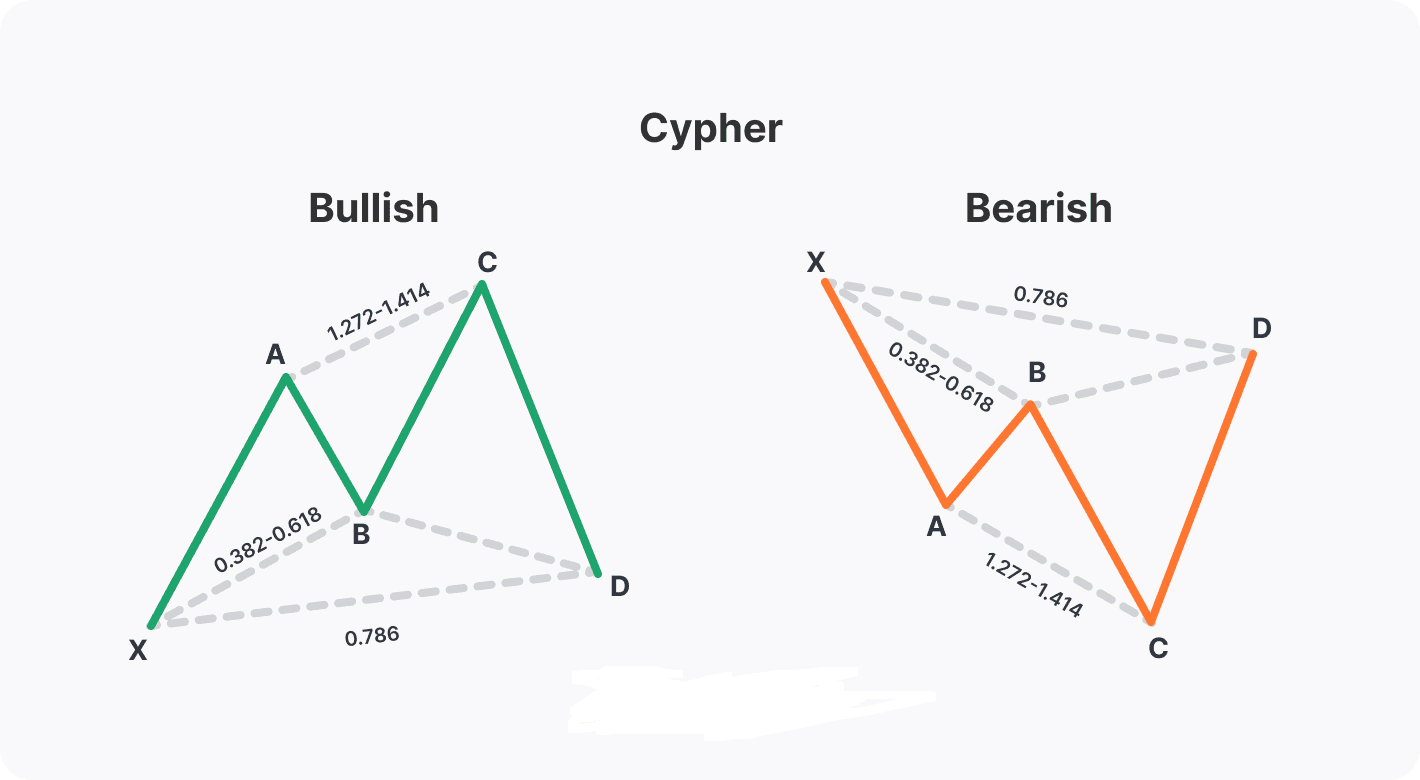
b) Shark Pattern: With X, A, B, and C points, the shark pattern identifies potential reversal zones, often preceding strong price movements.
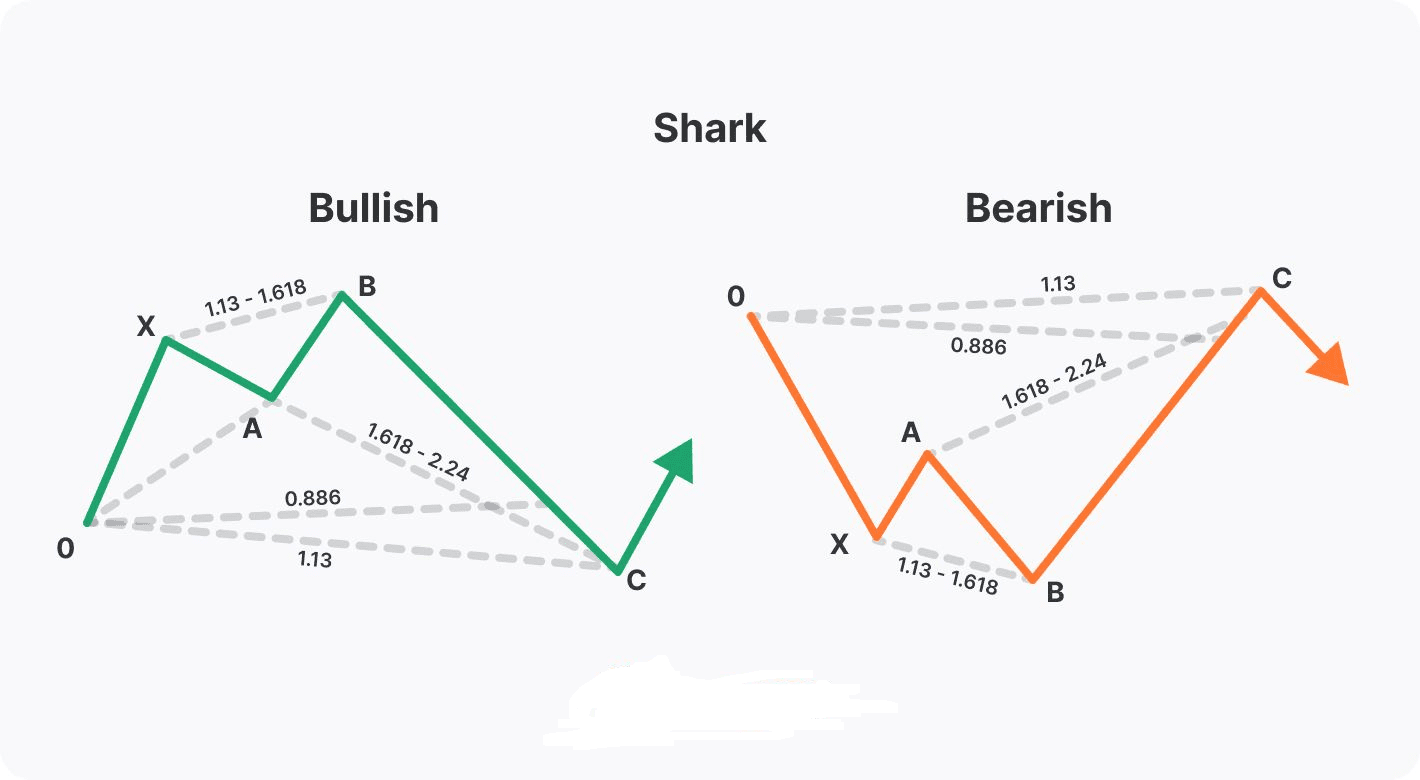
c) Crab Pattern: The crab pattern is characterized by its curved structure and can indicate potential reversal points.
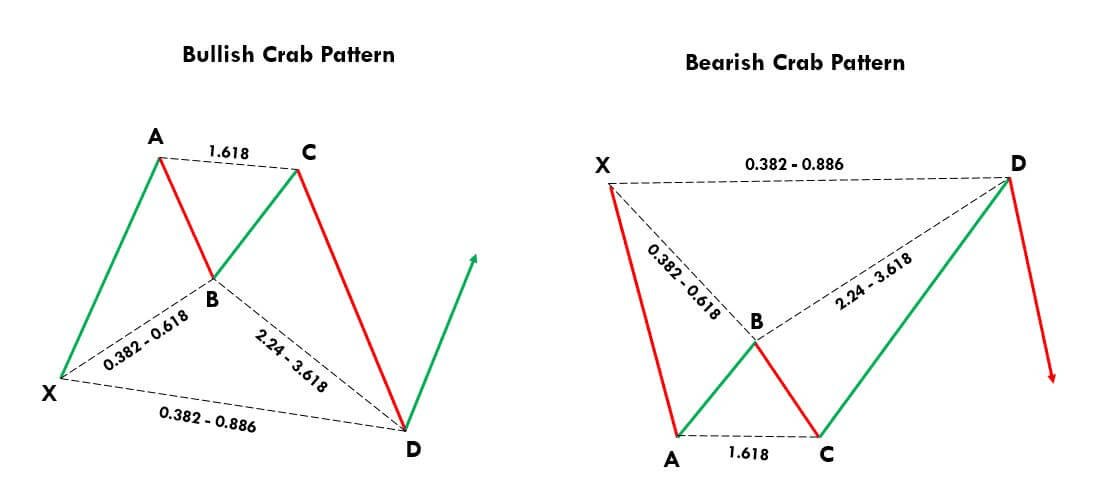
Techniques for Identifying Harmonic Patterns
To effectively trade harmonic patterns, traders must first be able to identify these patterns accurately. While it's a skill that requires practice and experience, there are several techniques that traders can use to increase their proficiency:
1) Draw Trendlines: Begin by drawing trendlines connecting significant price highs and lows on the chart. These trendlines can help highlight potential reversal or continuation zones.
2) Use Fibonacci Retracement and Extension Tools: Apply Fibonacci retracement and extension tools to the chart. Harmonic patterns are based on specific Fibonacci ratios, such as 0.618, 0.786, and 1.618. These tools help traders identify potential reversal and extension zones.
3) Check Ratios: Harmonic patterns rely on specific ratios between price moves. For example, in a Gartley pattern, the AB leg should ideally retrace 61.8% of the XA leg. The BC leg should retrace 38.2% of the AB leg, and so on. Pay attention to these ratios when assessing potential patterns.
4) Use Pattern Recognition Software: There are several pattern recognition software tools available that can automatically identify harmonic patterns on your charts. While these tools can be helpful, it's crucial to verify their accuracy through manual analysis.
5) Combine Patterns with Other Indicators: Harmonic patterns work best when used in conjunction with other technical indicators. Combining patterns with tools like moving averages, RSI (Relative Strength Index), or MACD (Moving Average Convergence Divergence) can provide additional confirmation.
Strategies for Trading Harmonic Patterns
Identifying harmonic patterns is only the first step; effective trading strategies are essential for translating these patterns into profitable trades. Here are some strategies to consider:
1) Wait for Confluence: Look for confluence points where multiple factors align. These could include the presence of a harmonic pattern, support or resistance levels, trendlines, and other technical indicators. Confluence increases the probability of a successful trade.
2) Trade in the Direction of the Pattern: If a bullish harmonic pattern forms, consider entering a long (buy) position. Conversely, if a bearish harmonic pattern appears, look for short (sell) opportunities. The direction of the pattern often aligns with the expected price movement.
3) Set Clear Entry and Exit Points: Determine precise entry and exit points for your trades. This can involve setting limit orders at specific price levels or waiting for price confirmation before entering a trade.
4) Use Proper Risk Management: Like any trading strategy, risk management is crucial when trading harmonic patterns. Never risk more than a small percentage of your trading capital on a single trade, and use stop-loss orders to protect against significant losses.
5) Consider Multiple Timeframes: Analyzing harmonic patterns across multiple timeframes can provide a more comprehensive view of the market's sentiment. A pattern that aligns across different timeframes is often more reliable.
6) Practice Patience: Not all potential harmonic patterns will result in profitable trades. Patience is essential, as waiting for high-probability setups increases your chances of success.
7) Back-test and Demo Trade: Before implementing harmonic pattern strategies in a live trading environment, consider back-testing and demo trading to validate the effectiveness of your approach. This practice also helps you become more comfortable with executing trades based on harmonic patterns.
Challenges and Considerations
While harmonic patterns offer traders a structured and systematic approach to trading, there are some challenges and considerations to keep in mind:
- Subjectivity: Identifying harmonic patterns involves a degree of subjectivity. Traders may interpret patterns differently, leading to variations in entry and exit points.
- False Signals: Not all harmonic patterns lead to successful trades. False signals can occur, and traders should be prepared for occasional losses.
- Market Conditions: Harmonic patterns may perform differently in different market conditions. It's essential to adapt your strategies to varying market trends.
- Continuous Learning: Mastering harmonic patterns requires continuous learning and practice. Markets evolve, and traders must stay updated with new patterns and refinements.
Footnote
Harmonic patterns provide traders with a structured methodology for understanding price movements and making informed trading decisions. By identifying these patterns and integrating them into a comprehensive trading strategy, traders can potentially enhance their ability to profit from the dynamic forex market. However, it's important to remember that no trading strategy is foolproof, and a combination of technical analysis, risk management, and continuous learning is key to success in the world of forex trading. Whether you're a novice trader exploring new strategies or an experienced trader seeking additional tools, harmonic patterns offer a unique perspective worth considering in your trading arsenal.











Discussion